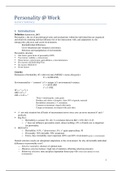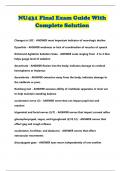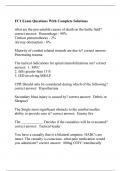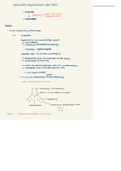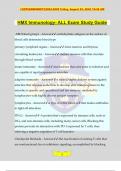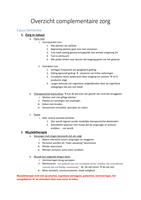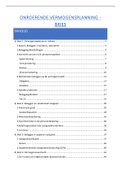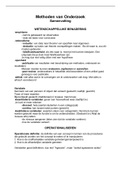Lecture Summary
1. Introduction
Definition (Larsen et al., 2017)
Personality = the set of psychological traits and mechanisms within the individual that are organized
and relatively enduring and that influence his or her interactions with, and adaptations to, the
intrapsychic, physical, and social environments.
Interindividual differences
Cross-situational and -temporal consistency
Selection and manipulation of environments
Personality structure
▪ One factor: great factor of personality (GFP)
▪ Two factors: stability + extraversion
▪ Three factors: extraversion, agreeableness, conscientiousness
▪ Five factors: OCEAN (Big Five)
▪ Six factors: HEXACO
▪ Seven factors
Genetics
Estimation of heritability (h2) with twin data (MZ/DZ = mono-/dizygotic):
h2 = 2(rMZ-rDZ)
Environmentality = ‘common’ (c2) + unique (e2) environmental variance:
c2 = 2rDZ-rMZ
e2 = 1-rMZ
2 2 2
H +c +e=1
rMZ = h2+ c2
rDZ = ½ h2+ c2
Twins = monozygotic: same genes
Brothers and sisters = dizygotic: share 50% of genetic material
Heritability estimation: r = correlation.
Common environment: shared with family
Unique environment: not shared with each other
▪ e2: not only situation but all kinds of measurement errors since you can never measure h2 and c2
perfectly.
▪ Big Five:
o Heritability is around .50 (.46) → correlation between MZ = 0.50, DZ = 0.25
o c2 does not influence personality much, almost nothing (.05) → Family not so important
for personality.
▪ HEXACO:
o Heritability: 0.54. c2 almost none (.01). e2 again approaching .50
o Personality: 50% heritable, 50% situational.
o Errors, thus: heritability more important (60%) and 40% environment (genes > environment)
Natural selection weeds out suboptimal adaptations to the environment. So why do heritable individual
differences in personality exist?
⎯ Selective neutrality: absence of optimal traits
⎯ Mutation-selection balance: high rate of mutation, offsetting selection pressures
⎯ Balancing selection: time and place dependent fitness pay-offs (some traits optimal to some
environments)
1
,Assumptions
Individual differences in traits have evolved … as a function of socio-physical environmental
variations and genetic variations & mutations … that have resulted in individual differences in a) size
& efficiency of personality-relevant brain regions and b) the manufacturing, proliferation, &
projection of and susceptibility to neurotransmitters / hormones in these regions ... causing individual
differences in (six) basic (e.g., independent) personality traits.
Neuroscience (DeYoung, 2010)
High conscientiousness, higher brain volume
Neuroticism: Dorsomedial PFC: regulations of emotions,
threats and errors
Neurotransmitters/hormones: so many, no consistency in
results, problem for research area
Personality Assessment at Work
a) Research: Predictive and incremental validity
b) Counseling: Vocational interest & fit
c) Selection: Prediction / P-O fit
d) Assessment: Career (managerial) potential / Career shift / International career
Personality ‘paradigms’
1. Lexical: main trait dimensions – mostly used nowadays (Galton, Cattell, Goldberg, Costa & McCrae, Ashton &
Lee)
2. Interpersonal: regularities in relations with others (Sullivan, Leary, Kiesler)
3. Biological: neurobiological individual differences (Eysenck, Zuckerman, Cloninger, DeYoung)
4. Personological: psychobiographical life history (Murray, McClelland, McAdams)
5. Empirical: correlates of psychiatric impairment (Kraepelin, Hathaway, Meehl)
6. Psychodynamic: dealing with unconscious drives (Freud, Rapaport, Blatt)
Sources of data
• Self-Report Data (S-Data) → ‘Identity’
• Other-Report Data (O-Data) → ‘Reputation’
• Life-Outcome Data (L-Data) or Biodata: Biographical data → Personological Paradigm
• Test Data (T-Data): Projective techniques → Psychodynamic Paradigm
Scientific & practical issues
1. Reliability:
Sufficient internal homogeneity: alpha or omega reliability
Temporal stability: test-retest reliability
Cross-rater agreement: interrater reliability (ICC)
2. Validity:
Construct validity: convergent & discriminant correlations
Predictive validity: predictor – criterion correlations
3. Credibility:
Objectivity: impartial assessor
Scientific rigor: standard testing procedure & use of adequate norm groups
4. Utility:
Added (monetary) value of assessment
Case study: Smipe Personality Analysis
Same profile for everybody.
SD: can say if a questionnaire is valid. Low SD: statement will apply to most people. Barnum
statement (Forer-effect): personality description applies to everybody.
Recognition not useful to say if test is a valid instrument.
2
, Personality typology
▪ MBTI problems: 1) theoretical unsound, 2) weak test-retest reliability (more than 50% of
respondents changes within a month to another ‘type’), 3) insufficient validity → really bad test.
▪ Do not rely on typologies, personality is dimensional (normal distribution).
▪ Types: reduces the systemic variance you have, which can reduce your predictive power.
2. Accuracy in Assessment
Accuracy of Ratings
Realistic Accuracy Model (RAM, Funder 1995)
If traits are not available, it is hard to detect
Correctly utilize and link behaviour to a trait, that is what
relevance is about
If every component’s accuracy is .5 → .5^4 = .06
To be able to say something about accuracy, we have to ‘decompose’
ratings not only into ‘target’ and ‘perceiver,’ but also ‘relationship’ effects → (dis)liking can have an effect on all
ratings you make about a person.
Social Relations Model (SRM) (Kenny, 1994)
• Person perception (P(T) or Xij) can be decomposed in separate effects:
Constant = #(#) or C0 = average level at which perceivers view targets on a trait
Perceiver = P(#) or Pi = the extent to which a perceiver sees other targets as high or low on a trait
Target = #(T) or Tj = the extent to which a target is seen by perceivers as high or low on a trait → ‘trait’
variance
Relationship = p(t) or Rij = the degree to which a given perceiver (Pi) sees a given target (Tj) as high or low on
a trait after controlling for perceiver & target effects
Error (eij)
• P(T) = #(#) + P(#) + #(T) + p(t) + error or: Xij = C0 + Pi + Tj + Rij + eij
• To optimize accurate rating, you need to have as much trait variance as possible → has to do with
the ‘real’ personality → look at the target effect (= intersubject agreement) e.g. selection assessment
• Perceiver / relationship effect is the bias of a perceiver
Block design
Two groups, each member of a subgroup rates all members of another subgroup
Use when there is not enough time to be both perceiver and target
E.g. company assessments, selection, assessment centre
SD is spread of the ratings
Tim is more lazy than Cal
Perceiver effect: perceiver’s ratings mean – the overall mean (=constant)
→ Pi = 5.8 – 6.0 = -0.2
Target effect: target’s ratings mean – the overall mean
→ Tj = 7.2 – 6.0 = 1.2
If you have perceiver and target effects, you can obtain the relationship effect
Relationship effect Joe & Abe = joe(abe) = X32 – (C0 + P3 + T2))
= R32
= 7 – ((6) + (-1.6) + (1.8))
= 7 – (6 – 1.6 + 1.8)
= 7 – 6.2 = 0.8
Tim – as a target: more lazy – in his relationships: differs per person (e.g. according
to Sam he’s very lazy, to Tom he’s less lazy)
Two interpretations: 1. Tim behaves differently to different people (e.g. friends vs. work)
2. Misperception because of characteristics of perceiver
3

